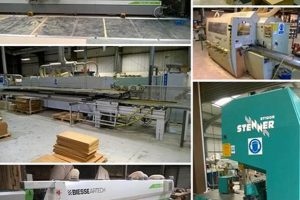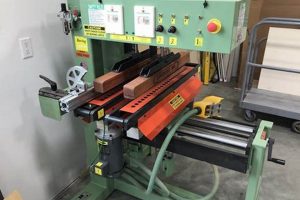Mobility solutions specifically designed for application on saws, planers, jointers, and other stationary woodworking equipment enable users to reposition these tools within a workshop setting. These mechanisms, typically incorporating robust casters or wheel assemblies, facilitate movement across various floor surfaces. An example includes a heavy-duty, retractable system mounted on a table saw, allowing it to be easily moved for cleaning or project reconfiguration.
The utilization of mobile bases or integrated wheel systems offers significant advantages within a woodworking environment. Increased workshop flexibility allows for optimized workflow and efficient use of space. Historically, woodworking machinery was often permanently fixed in place, limiting adaptability. Modern mobility solutions address this constraint, leading to improved productivity and reduced physical strain on operators. This adaptability proves particularly beneficial in smaller workshops or when reconfiguring layouts for specific projects.
The subsequent sections will explore the different types of these mobility solutions available, including considerations for weight capacity, floor surface compatibility, and installation methods. Furthermore, attention will be given to the selection criteria for optimizing performance and ensuring safety in various woodworking applications.
Considerations for Integrating Mobility Solutions
The selection and installation of equipment-specific movement mechanisms require careful consideration to ensure optimal performance and longevity of both the machinery and the floor surface.
Tip 1: Weight Capacity Assessment: Accurately determine the total weight of the woodworking machine, including any permanently attached accessories. Select systems rated to exceed this weight to prevent overloading and potential failure.
Tip 2: Floor Surface Compatibility: Evaluate the flooring material in the workshop. Polyurethane or rubberized wheels are generally suitable for concrete, while softer compounds may be necessary to prevent damage to wood or tile surfaces.
Tip 3: Retraction Mechanism Evaluation: If the chosen system includes a retraction mechanism, assess its ease of use and robustness. A well-designed mechanism should securely lock the machine in both the mobile and stationary positions.
Tip 4: Wheel Diameter and Configuration: Larger diameter configurations typically offer improved maneuverability, particularly on uneven surfaces. Consider the number of wheels and their placement to ensure stable weight distribution.
Tip 5: Brake System Implementation: For machines prone to vibration or those operating on sloped surfaces, a reliable brake system is essential. Ensure the brake mechanism is easily accessible and effectively prevents unwanted movement.
Tip 6: Mounting Hardware Selection: Utilize appropriate mounting hardware and techniques to securely attach the system to the woodworking machinery frame. Consult the manufacturer’s instructions and employ lock washers or thread-locking compounds to prevent loosening.
Effective integration of these mobility solutions can significantly enhance workshop efficiency and safety. However, proper planning and execution are critical to avoid potential issues related to stability, maneuverability, and equipment damage.
The following section will delve into specific types of systems and their suitability for different woodworking machinery applications.
1. Weight Capacity
Weight capacity is a paramount consideration when selecting mobility solutions for stationary woodworking machinery. Insufficient capacity can lead to structural failure, compromised maneuverability, and potential safety hazards. Choosing a system rated appropriately for the machine’s weight, including accessories, is essential for reliable and safe operation.
- Structural Integrity and Safety
Exceeding the stated weight limit of a wheel system can induce stress fractures in the frame, casters, or mounting points. This can result in sudden collapse, potentially causing damage to the machinery, the floor, and posing a risk of injury to personnel. Selecting a system with a safety margin above the calculated weight provides a buffer against unforeseen overloads and ensures structural integrity.
- Maneuverability and Rolling Resistance
Overloading a system significantly increases rolling resistance, making the machinery difficult to move and steer. This can negate the intended benefits of the mobility solution, creating frustration and potentially leading to unsafe maneuvering practices. Proper weight distribution across all wheels and adherence to the rated capacity are critical for maintaining optimal maneuverability.
- Wheel Bearing Longevity
Wheel bearings are particularly susceptible to damage from excessive weight. Over time, overloading can cause bearing deformation, increased friction, and premature failure. Replacing damaged bearings can be a costly and time-consuming process. Selecting a system with appropriately sized and rated bearings is essential for ensuring long-term reliability and minimizing maintenance requirements.
- Floor Protection and Surface Damage
While wheel material influences floor protection, exceeding the weight capacity can still lead to surface damage. Overloaded wheels exert greater pressure per unit area, potentially causing indentations, scratches, or even cracks, particularly on softer flooring materials. Adhering to the specified weight limit helps distribute the load evenly and minimize the risk of floor damage.
The interplay between weight capacity and the structural components of these mobility systems directly affects the long-term performance and safety of woodworking machinery. Diligent assessment of machinery weight and selection of an appropriately rated wheel system are fundamental for ensuring a functional and safe workshop environment. Moreover, regular inspection of the wheel system for signs of wear or damage is crucial for maintaining its integrity and preventing potential failures.
2. Wheel Material
The selection of wheel material is a critical determinant of performance and longevity in mobility solutions for woodworking machinery. The material properties directly impact traction, load-bearing capacity, floor protection, and overall durability. The suitability of a specific material depends on the weight of the machinery, the type of flooring, and the operational environment.
- Polyurethane: Durability and Versatility
Polyurethane wheels offer a balance of durability, load capacity, and resistance to abrasion. They are well-suited for concrete floors and can withstand heavy use in demanding workshop environments. Their moderate hardness provides adequate traction while minimizing the risk of floor damage. Examples include heavy-duty table saws and planers, where robustness and longevity are paramount.
- Rubber: Floor Protection and Noise Reduction
Rubber wheels, particularly those made from softer compounds, are ideal for protecting sensitive flooring surfaces such as hardwood or tile. They also offer excellent noise reduction, making them suitable for workshops where noise levels need to be minimized. However, rubber wheels generally have lower load capacities and may wear more quickly than polyurethane options. Applications include lighter-weight equipment or machinery used on finished floors.
- Phenolic: High Load Capacity and Chemical Resistance
Phenolic wheels are characterized by their exceptional load-bearing capacity and resistance to chemicals and solvents. They are well-suited for extremely heavy machinery or environments where exposure to harsh chemicals is likely. However, phenolic wheels are very hard and can damage softer flooring surfaces. They are often used in industrial woodworking settings where durability and chemical resistance outweigh concerns about floor protection.
- Cast Iron: Extreme Durability and Temperature Resistance
Cast iron wheels offer the highest level of durability and temperature resistance, making them suitable for extreme applications. However, they provide minimal floor protection and can be noisy during operation. Their use is limited in typical woodworking environments due to the potential for floor damage and noise concerns. They might be found in older machinery or specialized industrial settings where these factors are less critical.
The choice of wheel material directly influences the performance characteristics and suitability of mobility solutions for woodworking machinery. Careful consideration of the flooring type, machinery weight, and operational environment is crucial for selecting the optimal material. Neglecting this factor can result in compromised performance, accelerated wear, or damage to the workshop floor.
3. Locking Mechanisms
Locking mechanisms are integral components of mobility systems designed for stationary woodworking machinery. The absence of effective locking mechanisms renders these systems functionally incomplete and potentially hazardous. Their primary function is to securely immobilize the equipment once it has been positioned, preventing unintended movement during operation. This is particularly crucial for machinery that generates significant vibration or is used on slightly uneven surfaces. For example, a jointer or planer, when in use, produces forces that could cause a mobile base without adequate locking to shift gradually, affecting the precision of the work and posing a safety risk to the operator.
Various locking mechanisms are employed, each with its own advantages and disadvantages. Foot-activated levers are common, providing a convenient means of engaging and disengaging the lock. These levers typically act on a brake pad that presses against the wheel, preventing rotation. Other systems utilize locking swivel casters, which restrict both wheel rotation and swivel movement. The effectiveness of a locking mechanism is dependent on its design, materials, and the weight of the machinery it is intended to support. A poorly designed or undersized locking mechanism may fail to adequately secure the equipment, compromising safety and precision. Furthermore, environmental factors, such as the presence of sawdust or debris, can affect the functionality of certain locking mechanisms, requiring regular maintenance to ensure reliable operation.
In conclusion, the incorporation of robust and reliable locking mechanisms is essential for ensuring the safe and effective use of mobile bases and wheel systems for stationary woodworking machinery. The selection of an appropriate locking mechanism should be based on the weight and operational characteristics of the machinery, the type of flooring, and the user’s specific needs. Regular inspection and maintenance of these mechanisms are critical for maintaining their functionality and preventing potential accidents. The failure to prioritize effective locking mechanisms represents a significant oversight that can undermine the benefits of a mobile workshop configuration.
4. Maneuverability
Maneuverability, defined as the ease with which a piece of woodworking machinery can be moved and positioned within a workshop, is directly and substantially influenced by the design and specifications of its integrated wheel system. The dimensions and configuration of these apparatus, the materials utilized in their construction, and the presence or absence of features such as swivel casters all contribute to the effort required to relocate the equipment. For instance, a table saw equipped with small-diameter, fixed wheels exhibits limited maneuverability, demanding considerable physical exertion to navigate tight corners or reposition across uneven surfaces. Conversely, a similar machine fitted with larger-diameter, swivel casters facilitates effortless movement and precise placement.
The importance of maneuverability in the context of woodworking machinery extends beyond mere convenience; it has significant implications for workshop efficiency, safety, and workflow optimization. In environments where space is limited or where machinery must be frequently repositioned to accommodate different project requirements, enhanced maneuverability translates directly into reduced setup times, improved accessibility, and minimized physical strain on operators. Consider a scenario where a woodworker routinely alternates between using a jointer and a planer. If these machines are equipped with highly maneuverable wheel systems, the time and effort required to reconfigure the workshop layout are substantially reduced, allowing for more productive use of time. Furthermore, improved control over machinery movement minimizes the risk of collisions or accidental damage to other equipment or materials within the workshop.
In summary, the relationship between maneuverability and wheel systems in woodworking machinery is characterized by a clear cause-and-effect dynamic. The specifications of the wheel system directly influence the ease of movement, which, in turn, affects workshop efficiency, safety, and workflow. While advancements in wheel system technology have demonstrably improved maneuverability, challenges remain in balancing this factor with other considerations such as weight capacity, stability, and cost. Recognizing the practical significance of this interplay is essential for woodworkers seeking to optimize their workshop layout and enhance the overall productivity of their operations.
5. Installation Method
The installation method for wheel systems on woodworking machinery critically affects their performance, longevity, and safety. The connection between the installation method and the functionality of the wheels is direct and consequential. Incorrect installation can compromise the stability of the machinery, negate the intended benefits of mobility, and potentially create hazardous working conditions. For example, if a wheel system is attached using fasteners of insufficient strength or inappropriate placement, the system may fail under load, leading to equipment damage or operator injury. The importance of proper installation cannot be overstated; it is an intrinsic component of the overall effectiveness of the mobility solution.
Different woodworking machines necessitate diverse installation approaches. Smaller, lighter machines may be suitable for bolt-on systems that attach directly to the existing frame. Larger, heavier equipment, such as industrial-grade planers or jointers, may require welding or reinforcement of the frame to ensure adequate support for the wheel system. Furthermore, the specific installation method must account for the machine’s weight distribution and center of gravity. Failure to properly distribute the load across all wheels can lead to uneven wear, instability, and increased risk of tipping. Real-life examples include cases where improperly installed wheel systems have caused table saws to become unstable during operation, leading to kickback incidents and potential injuries. Careful attention to manufacturer instructions and the use of appropriate tools and techniques are essential for successful and safe installation.
In summary, the installation method is inextricably linked to the effective functioning of wheel systems on woodworking machinery. Proper installation ensures stability, safe operation, and optimal performance. Challenges include accommodating the wide variety of machinery designs and weight configurations. A thorough understanding of the installation requirements, coupled with meticulous execution, is paramount for realizing the full benefits of mobility in a woodworking environment and preventing potential hazards.
Frequently Asked Questions
The following section addresses common inquiries regarding the selection, implementation, and maintenance of wheels for woodworking machinery. The information provided aims to offer clarity and guidance for users seeking to enhance the mobility and efficiency of their workshops.
Question 1: What factors should influence the selection of wheel material for woodworking machinery?
Wheel material selection is dictated by flooring type, machinery weight, and operating environment. Polyurethane offers durability on concrete. Rubber provides protection for sensitive surfaces. Phenolic provides a high load capacity.
Question 2: How is weight capacity determined for a mobile base designed for a table saw?
The total weight of the table saw, including any permanently attached accessories, must be accurately assessed. The mobile base should be rated to exceed this weight to prevent overloading and ensure stability.
Question 3: What are the implications of using an undersized wheel system on heavy woodworking equipment?
Using an undersized system can lead to structural failure, compromised maneuverability, increased rolling resistance, and potential safety hazards. Damage to flooring and premature wear of wheel bearings are also likely.
Question 4: Why are locking mechanisms essential for wheel systems on stationary woodworking machinery?
Locking mechanisms prevent unintended movement during operation, especially with machinery generating vibration or operating on uneven surfaces. This ensures stability and prevents accidental shifting that could compromise precision or safety.
Question 5: How does wheel diameter impact the maneuverability of a mobile base?
Larger diameter wheels generally offer improved maneuverability, particularly on uneven surfaces. They reduce the effort required to overcome obstacles and navigate within the workshop environment.
Question 6: What are the key considerations for ensuring proper installation of a wheel system on a woodworking machine?
Proper installation requires utilizing appropriate mounting hardware, accounting for weight distribution, and adhering to manufacturer instructions. Failure to do so can compromise stability and create unsafe operating conditions.
Properly selected and installed mobility solutions can significantly enhance workshop efficiency and safety. However, careful planning and execution are critical to avoid potential issues related to stability, maneuverability, and equipment damage.
The next section delves into case studies illustrating successful and unsuccessful implementations of mobility solutions in various woodworking settings.
Conclusion
The preceding exploration of “wheels for woodworking machinery” has underscored the critical role these components play in modern woodworking environments. Factors such as weight capacity, wheel material, locking mechanisms, maneuverability, and installation methods were highlighted as paramount considerations in ensuring both operational efficiency and user safety.
Effective implementation of mobility solutions demands a thorough understanding of workshop-specific requirements and a commitment to diligent maintenance practices. Ignoring these principles risks compromising equipment stability and operator well-being. Continuous advancements in materials science and engineering will likely drive further innovation in this domain, offering increased performance and enhanced safety features. Prudent adoption of these advancements is essential for maximizing productivity and fostering a secure woodworking workspace.







